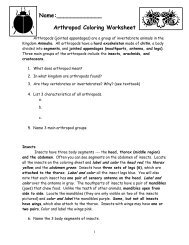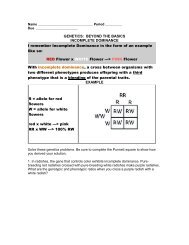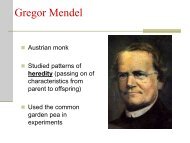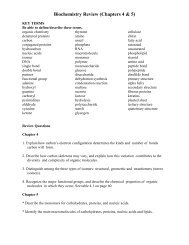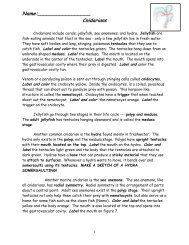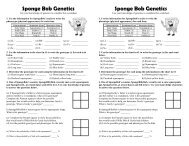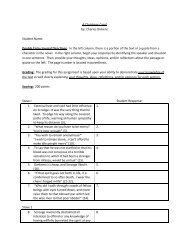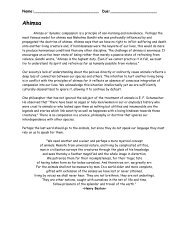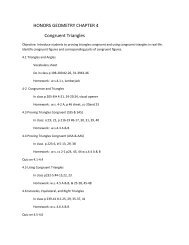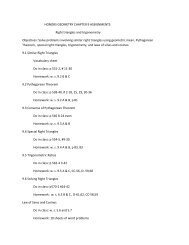Chapter 4: Sensation and Perception
Chapter 4: Sensation and Perception
Chapter 4: Sensation and Perception
- No tags were found...
You also want an ePaper? Increase the reach of your titles
YUMPU automatically turns print PDFs into web optimized ePapers that Google loves.
<strong>Sensation</strong> <strong>and</strong> <strong>Perception</strong>Original Content Copyright by HOLT McDougal. Additions <strong>and</strong> changes to the original content are the responsibility of the instructor.<strong>Sensation</strong> <strong>and</strong> <strong>Perception</strong>Thinking Critically• In what ways do people benefit from animals’ supersenses?• How might animals supplement disaster warningsystems?Original Content Copyright by HOLT McDougal. Additions <strong>and</strong> changes to the original content are the responsibility of the instructor.<strong>Sensation</strong> <strong>and</strong> <strong>Perception</strong>Section 2 at a GlanceVision• Light enters the eye, which relays information to the brain<strong>and</strong> allows us to see.• People with normal color vision can see all colors in thespectrum of visible light.• People who do not have normal color vision are said tobe “color blind.”Original Content Copyright by HOLT McDougal. Additions <strong>and</strong> changes to the original content are the responsibility of the instructor.7
<strong>Sensation</strong> <strong>and</strong> <strong>Perception</strong>VisionMain IdeaLight interacting with the eye allows us to see. People with normalvision can adapt to changing light conditions <strong>and</strong> can see any color inthe spectrum of visible light.Reading Focus• How does light work?• What are the main parts of the eye?• What allows us to have color vision?• What causes color blindness?Original Content Copyright by HOLT McDougal. Additions <strong>and</strong> changes to the original content are the responsibility of the instructor.<strong>Sensation</strong> <strong>and</strong> <strong>Perception</strong>What color areyou feeling?Original Content Copyright by HOLT McDougal. Additions <strong>and</strong> changes to the original content are the responsibility of the instructor.<strong>Sensation</strong> <strong>and</strong> <strong>Perception</strong>Light• Light: electromagnetic energy described in wavelengths• Electromagnetic spectrum: light that is visible to humans <strong>and</strong> lightthat is not• The light that humans can see makes up only a small part of thespectrum.• The main colors of the spectrum are:– red– orange– yellow– green– blue– indigo– violetOriginal Content Copyright by HOLT McDougal. Additions <strong>and</strong> changes to the original content are the responsibility of the instructor.8
<strong>Sensation</strong> <strong>and</strong> <strong>Perception</strong>Reading CheckSummarizeWhat is light?Answer: Light is electromagnetic energy. Theelectromagnetic spectrum is made up of light thatis visible to humans <strong>and</strong> light that is not.Original Content Copyright by HOLT McDougal. Additions <strong>and</strong> changes to the original content are the responsibility of the instructor.<strong>Sensation</strong> <strong>and</strong> <strong>Perception</strong>The Eye• The amount of light that enters the eye is determined by the size of theopening in the colored part of the eye, which is the pupil.• The lens adjusts to the distance of objects by changing its thickness.• The retina is a sensitive surface that consists of neurons.• Neurons that are sensitive to light are called photoreceptors.The Blind Spot• When light hits the point where the opticnerve leaves the eye, the eye registersnothing because that area lacksphotoreceptors.• The area that does not havephotoreceptors is called the blind spot.• Everyone has a blind spot.Rods <strong>and</strong> Cones• The two kinds of photoreceptors arerods <strong>and</strong> cones.• Rods are sensitive only to brightness<strong>and</strong> allow us to see black <strong>and</strong> white.• Cones provide color vision.• Rods are more sensitive to light thanare cones.Original Content Copyright by HOLT McDougal. Additions <strong>and</strong> changes to the original content are the responsibility of the instructor.<strong>Sensation</strong> <strong>and</strong> <strong>Perception</strong>Dark <strong>and</strong> Light Adaptation• The adjustment to lower levels oflight is called dark adaptation.• The ability to see in low lightcontinues to improve for up to 45minutes.• Adaptation to bright light occurswithin a minute or two.• Adaptation to bright light happensmuch more quickly than adaptationto the dark.Visual Acuity• Visual acuity is the sharpness ofvision.• It is determined by the ability tosee visual details in normal light.• Eye charts are used to measurevisual acuity.• Being nearsighted means aperson has to be close to anobject to make out its details.• Being farsighted means a personhas to be farther away from anobject to make out its details.• As people age, they become morefarsighted.Original Content Copyright by HOLT McDougal. Additions <strong>and</strong> changes to the original content are the responsibility of the instructor.9
<strong>Sensation</strong> <strong>and</strong> <strong>Perception</strong>Original Content Copyright by HOLT McDougal. Additions <strong>and</strong> changes to the original content are the responsibility of the instructor.<strong>Sensation</strong> <strong>and</strong> <strong>Perception</strong>Reading CheckCompareIn what way is the eye like a camera?Answer: As in a camera, light enters an opening;in the eye, it is the pupil, which adjustsautomatically to the light. The lens adjusts to thedistance of objects, a clear image is projected, <strong>and</strong>then the retina acts like the film in a camera.Original Content Copyright by HOLT McDougal. Additions <strong>and</strong> changes to the original content are the responsibility of the instructor.<strong>Sensation</strong> <strong>and</strong> <strong>Perception</strong>Color VisionThe Color Wheel• The color wheel is made up of thecolors of the spectrum bent into acircle.• Complementary colors are the colorsacross from each other on the colorwheel.• Color visions refers to light. It doesnot refer to pigments.• When complementary colors of lightmix, they form gray.Cones <strong>and</strong> Color Vision• In humans, some cones aresensitive to blue, some to green,<strong>and</strong> some to red.• When more than one kind of cone isstimulated, we perceive othercolors.• Human color vision differs from thatof many animals.• Fish have no cones <strong>and</strong> see nocolor.• Dogs have two types of cones <strong>and</strong>see fewer colors than humans.• Birds have four or more cones <strong>and</strong>see a wide variety of colors.Original Content Copyright by HOLT McDougal. Additions <strong>and</strong> changes to the original content are the responsibility of the instructor.10
<strong>Sensation</strong> <strong>and</strong> <strong>Perception</strong>Afterimages• An afterimage is the visual impression that remains after the originalimage is removed.– The afterimage is the complementary color of the color of the originalimage.– The afterimage of black is white.– The afterimage of white is black.• Most afterimages last a few seconds up to a minute.– They occur when the cones of the eye become tired after staringintensely at a single color.– The size of an afterimage depends of the distance from which it isviewed.Original Content Copyright by HOLT McDougal. Additions <strong>and</strong> changes to the original content are the responsibility of the instructor.<strong>Sensation</strong> <strong>and</strong> <strong>Perception</strong>Original Content Copyright by HOLT McDougal. Additions <strong>and</strong> changes to the original content are the responsibility of the instructor.<strong>Sensation</strong> <strong>and</strong> <strong>Perception</strong>Original Content Copyright by HOLT McDougal. Additions <strong>and</strong> changes to the original content are the responsibility of the instructor.11
<strong>Sensation</strong> <strong>and</strong> <strong>Perception</strong>Reading CheckIdentify Cause <strong>and</strong> EffectWhat happens after you look intensely at asingle color?Answer: The afterimage will appear, <strong>and</strong> it will bethe complementary color, not the color that wasfocused on.Original Content Copyright by HOLT McDougal. Additions <strong>and</strong> changes to the original content are the responsibility of the instructor.<strong>Sensation</strong> <strong>and</strong> <strong>Perception</strong>Color Blindness• Normal color vision: when a person can see colors of the visiblespectrum• Color blindness: when people do not have normal color vision due toa malfunction in the cones• Partial color blindness is common; total color blindness is rare.• Most people who are color blind have red-green color blindness.• Color blindness is almost always inherited.• Males are more likely to inherit color blindness.• There is no cure for color blindness, but it does not cause any greatimpairment.Original Content Copyright by HOLT McDougal. Additions <strong>and</strong> changes to the original content are the responsibility of the instructor.<strong>Sensation</strong> <strong>and</strong> <strong>Perception</strong>Original Content Copyright by HOLT McDougal. Additions <strong>and</strong> changes to the original content are the responsibility of the instructor.12
<strong>Sensation</strong> <strong>and</strong> <strong>Perception</strong>Reading CheckDraw ConclusionsWhat difficulties might a person with redgreencolor blindness encounter whencooking red meat?Answer: unable to detect shades of red, raw, rare,<strong>and</strong> medium rare meatOriginal Content Copyright by HOLT McDougal. Additions <strong>and</strong> changes to the original content are the responsibility of the instructor.<strong>Sensation</strong> <strong>and</strong> <strong>Perception</strong>Section 3 at a GlanceHearing• The ear allows us to hear <strong>and</strong> locate sounds, which havetheir own pitch <strong>and</strong> loudness.• Deafness may be inherited or caused by disease, injury,or old age.Original Content Copyright by HOLT McDougal. Additions <strong>and</strong> changes to the original content are the responsibility of the instructor.<strong>Sensation</strong> <strong>and</strong> <strong>Perception</strong>HearingMain IdeaThe ear is the human instrument for sensing sounds. When parts of theear are damaged, deafness can occur.Reading Focus• What two characteristics does every sound have?• What are the main parts of the ear, <strong>and</strong> how do they work?• What are some of the causes of deafness?Original Content Copyright by HOLT McDougal. Additions <strong>and</strong> changes to the original content are the responsibility of the instructor.13
<strong>Sensation</strong> <strong>and</strong> <strong>Perception</strong>What does colorsound like?Original Content Copyright by HOLT McDougal. Additions <strong>and</strong> changes to the original content are the responsibility of the instructor.<strong>Sensation</strong> <strong>and</strong> <strong>Perception</strong>Sound• Sound is caused by changes in air pressure that result from vibration.• Each vibration is called a cycle or a sound wave.• Every sound has its own pitch <strong>and</strong> loudness.Pitch• The pitch of a sound is how high orlow it is.• Pitch depends on the frequency ofsound.• Frequency is the number of cyclesper second.• The more cycles per second, thehigher the pitch of a sound.Loudness• Loudness is determined by theheight, or amplification, of soundwaves.• The higher the amplification, thelouder the sound.• Loudness is measured in decibels.Original Content Copyright by HOLT McDougal. Additions <strong>and</strong> changes to the original content are the responsibility of the instructor.<strong>Sensation</strong> <strong>and</strong> <strong>Perception</strong>Reading CheckFind the Main IdeaHow do we hear sound?Answer: changes in air pressure that result fromvibrationOriginal Content Copyright by HOLT McDougal. Additions <strong>and</strong> changes to the original content are the responsibility of the instructor.14
<strong>Sensation</strong> <strong>and</strong> <strong>Perception</strong>Original Content Copyright by HOLT McDougal. Additions <strong>and</strong> changes to the original content are the responsibility of the instructor.<strong>Sensation</strong> <strong>and</strong> <strong>Perception</strong>The EarThe ear is shaped to recognize <strong>and</strong> capture sound waves. The brain<strong>and</strong> nervous system actually hear the sounds.The ear has three parts: the outer ear, the middle ear, <strong>and</strong> the inner ear.Anatomy• The eardrum transmits sound to thebones in the middle ear, which thentransmit sound to the inner ear.• The inner ear consists of thecochlea. Sound makes the fluidwithin the cochlea vibrate, sendingneuron impulses to the brain via theauditory nerve.Locating Sound• We can locate sound by turning thehead to increase the sound.• We use visual cues to locatesound.Original Content Copyright by HOLT McDougal. Additions <strong>and</strong> changes to the original content are the responsibility of the instructor.<strong>Sensation</strong> <strong>and</strong> <strong>Perception</strong>Click on the image to play the Interactive.Original Content Copyright by HOLT McDougal. Additions <strong>and</strong> changes to the original content are the responsibility of the instructor.15
<strong>Sensation</strong> <strong>and</strong> <strong>Perception</strong>Reading CheckSummarizeHow does the cochlea carry sound to thebrain?Answer: The fluid within the cochlea vibrates, sending neuronimpulses to the brain.Original Content Copyright by HOLT McDougal. Additions <strong>and</strong> changes to the original content are the responsibility of the instructor.<strong>Sensation</strong> <strong>and</strong> <strong>Perception</strong>DeafnessConductive Deafness• Conductive deafness occurs because of damage to the middle ear,which is the part that amplifies sound.• Hearing aids can provide for the function of the middle ear byamplifying sound.Sensorineural Deafness• Sensorineural deafness occurs when sounds of certain frequenciesare not heard.• It is usually caused by damage to the inner ear.• Loud sounds can destroy neurons in the ear.• Cochlear implants can help people with sensorineural deafness.Original Content Copyright by HOLT McDougal. Additions <strong>and</strong> changes to the original content are the responsibility of the instructor.<strong>Sensation</strong> <strong>and</strong> <strong>Perception</strong>Deafness in the World Today• In recent years, deaf people have been able to come more into themainstream of sensory experience.• Some deaf people choose not to enter into the mainstream ofsensory experience.• Society has recently become more sensitive to the needs of deafpeople through the use of the following:– interpreters– more courses in American Sign Language– “close captioned” television shows– advances in repairing damage inside the earOriginal Content Copyright by HOLT McDougal. Additions <strong>and</strong> changes to the original content are the responsibility of the instructor.16
<strong>Sensation</strong> <strong>and</strong> <strong>Perception</strong>Reading CheckContrastWhat are some of the differences betweenconductive <strong>and</strong> sensorineural deafness?Answer: Conductive deafness occurs when there is damageto the middle ear <strong>and</strong> it affects not being about to hear soundsloud enough. Sensorineural deafness occurs with damage to theinner ear <strong>and</strong> it affects hearing sounds of certain frequencies.Original Content Copyright by HOLT McDougal. Additions <strong>and</strong> changes to the original content are the responsibility of the instructor.<strong>Sensation</strong> <strong>and</strong> <strong>Perception</strong>Current Research in PsychologyThe Bionic EarFor those who are severely hard of hearing or profoundly deaf, the world ismostly a silent place. But in 1985, when the cochlear implant was approved fortesting, the technology held out great hope for the deaf. Since its introduction,however, the device has been a source of controversy <strong>and</strong> has divided the deafcommunity.• A cochlear implant is a smallelectronic device that is surgicallyplaced behind the ear.• The device generates signals thatthe auditory nerve conveys to thebrain.• The recipient must learn how tounderst<strong>and</strong> the sounds it transmits.• Some deaf people questioned thepsychological impact of the deviceon children.• In recent years, opposition to theimplant has decreased.• The implant has support from manymembers of the deaf community.Original Content Copyright by HOLT McDougal. Additions <strong>and</strong> changes to the original content are the responsibility of the instructor.<strong>Sensation</strong> <strong>and</strong> <strong>Perception</strong>Original Content Copyright by HOLT McDougal. Additions <strong>and</strong> changes to the original content are the responsibility of the instructor.17
<strong>Sensation</strong> <strong>and</strong> <strong>Perception</strong>Original Content Copyright by HOLT McDougal. Additions <strong>and</strong> changes to the original content are the responsibility of the instructor.<strong>Sensation</strong> <strong>and</strong> <strong>Perception</strong>Thinking Critically• How does a cochlear implant differ from a hearing aid?• How do you think you would feel about cochlear implantsif you were deaf?Original Content Copyright by HOLT McDougal. Additions <strong>and</strong> changes to the original content are the responsibility of the instructor.<strong>Sensation</strong> <strong>and</strong> <strong>Perception</strong>Section 4 at a GlanceOther Senses• We perceive smell <strong>and</strong> taste by sensing the molecules ofcertain substances.• Sensory receptors on our skin allow us to sensepressure, temperature, <strong>and</strong> pain.• Body senses help us keep our balance <strong>and</strong> st<strong>and</strong> upstraight.Original Content Copyright by HOLT McDougal. Additions <strong>and</strong> changes to the original content are the responsibility of the instructor.18
<strong>Sensation</strong> <strong>and</strong> <strong>Perception</strong>Other SensesMain IdeaIn addition to vision <strong>and</strong> hearing, people possess the senses of smell<strong>and</strong> taste. We also have skin <strong>and</strong> body senses.Reading Focus• How do people sense smell <strong>and</strong> taste?• What are the skin senses?• What body senses allow us to st<strong>and</strong> upright <strong>and</strong> coordinate ourmovements?Original Content Copyright by HOLT McDougal. Additions <strong>and</strong> changes to the original content are the responsibility of the instructor.<strong>Sensation</strong> <strong>and</strong> <strong>Perception</strong>What's on the tipof your tongue?Original Content Copyright by HOLT McDougal. Additions <strong>and</strong> changes to the original content are the responsibility of the instructor.<strong>Sensation</strong> <strong>and</strong> <strong>Perception</strong>Smell <strong>and</strong> TasteSmell• People do not have as strong a sense of smell as many animals do.• Odors are detected by receptor neurons in the nose.• The receptors send information about the odors to the brain via theolfactory nerve.Taste• Most researchers agree on four basic taste qualities: sweet, sour,salty, <strong>and</strong> bitter.• We sense taste through receptor neurons located on taste buds onthe tongue.• Taste cells reproduce rapidly.Original Content Copyright by HOLT McDougal. Additions <strong>and</strong> changes to the original content are the responsibility of the instructor.19
<strong>Sensation</strong> <strong>and</strong> <strong>Perception</strong>Reading CheckIdentify Supporting DetailsWhat are the four basic taste qualities?Answer: sweet, salty, sour, <strong>and</strong> bitterOriginal Content Copyright by HOLT McDougal. Additions <strong>and</strong> changes to the original content are the responsibility of the instructor.<strong>Sensation</strong> <strong>and</strong> <strong>Perception</strong>The Skin SensesPressure• The body is covered with hairs, some very tiny.• Sensory receptors in the hair cells fire where the skin is touched.• Other structures beneath the skin are also sensitive to pressure.• The sense of pressure undergoes rapid adaptation.Temperature• <strong>Sensation</strong>s of temperature are relative.• Neurons beneath the skin’s surface are receptors for temperature.• As with the sense of pressure, people adapt rapidly to the sense oftemperature.Original Content Copyright by HOLT McDougal. Additions <strong>and</strong> changes to the original content are the responsibility of the instructor.<strong>Sensation</strong> <strong>and</strong> <strong>Perception</strong>Pain• The more pain receptors located in a particular area, the moresensitive that area is.• Pain moves from the point of contact to the spinal cord <strong>and</strong> then tothe thalamus in the brain.• It is then projected to the cerebral cortex, where the person registersthe location <strong>and</strong> severity of the pain.• Chemicals called prostagl<strong>and</strong>ins help transmit pain messages to thebrain.• The gate theory of pain suggests that only a certain amount ofinformation can be processed by the nervous system at a time.Rubbing or scratching an injured area transmits sensations to thebrain that compete with the pain messages. This can have the effectof relieving pain.Original Content Copyright by HOLT McDougal. Additions <strong>and</strong> changes to the original content are the responsibility of the instructor.20
<strong>Sensation</strong> <strong>and</strong> <strong>Perception</strong>Original Content Copyright by HOLT McDougal. Additions <strong>and</strong> changes to the original content are the responsibility of the instructor.<strong>Sensation</strong> <strong>and</strong> <strong>Perception</strong>Reading CheckSummarizeHow do our bodies deal with changingpressure <strong>and</strong> temperature?Answer: After a while, our bodies adapt to changes intemperature <strong>and</strong> pressure.Original Content Copyright by HOLT McDougal. Additions <strong>and</strong> changes to the original content are the responsibility of the instructor.<strong>Sensation</strong> <strong>and</strong> <strong>Perception</strong>Body SensesThe Vestibular Sense• Vestibular sense tells you whether you are physically upright withouthaving to use your eyes.• It works via sensory organs in the ear that monitor the body’s motion<strong>and</strong> position in relation to gravity.Kinesthesis• Kinesthesis is the sense that informs people about the position <strong>and</strong>motion of their bodies.• It works via sensory organs in the joints, tendons, <strong>and</strong> muscles thatsend information to the brain.Original Content Copyright by HOLT McDougal. Additions <strong>and</strong> changes to the original content are the responsibility of the instructor.21
<strong>Sensation</strong> <strong>and</strong> <strong>Perception</strong>Reading CheckDraw ConclusionsWhat prevents you from falling over whenyou st<strong>and</strong> up?Answer: vestibular sense <strong>and</strong> kinesthesisOriginal Content Copyright by HOLT McDougal. Additions <strong>and</strong> changes to the original content are the responsibility of the instructor.<strong>Sensation</strong> <strong>and</strong> <strong>Perception</strong>Section 5 at a Glance<strong>Perception</strong>• <strong>Perception</strong> allows us to organize <strong>and</strong> make sense of oursensory impressions.• Cues help people perceive movement <strong>and</strong> motion <strong>and</strong>judge depth <strong>and</strong> perspective.• The brain can trick the eye through visual illusions.Original Content Copyright by HOLT McDougal. Additions <strong>and</strong> changes to the original content are the responsibility of the instructor.<strong>Sensation</strong> <strong>and</strong> <strong>Perception</strong><strong>Perception</strong>Main Idea<strong>Perception</strong> is the way in which we organize our sensory impressions.Movement, depth, <strong>and</strong> constancy are some of the ways in which wemake sense of these impressions.Reading Focus• What are the main rules of perceptual organization?• How is movement perceived?• What cues do we use for depth perception?• What are perceptual constancies?• Why do we see visual illusions?Original Content Copyright by HOLT McDougal. Additions <strong>and</strong> changes to the original content are the responsibility of the instructor.22
<strong>Sensation</strong> <strong>and</strong> <strong>Perception</strong>How do you feel whenyou look down?Original Content Copyright by HOLT McDougal. Additions <strong>and</strong> changes to the original content are the responsibility of the instructor.<strong>Sensation</strong> <strong>and</strong> <strong>Perception</strong>Rules of Perceptual OrganizationClosure• Closure is the tendency to perceive a complete or whole figure evenwhen there are gaps in what your senses tell you.• It works when you try to fit pieces of information into a familiarpattern.Figure-Ground <strong>Perception</strong>• Figure-ground perception is the perception of figures against abackground.Original Content Copyright by HOLT McDougal. Additions <strong>and</strong> changes to the original content are the responsibility of the instructor.<strong>Sensation</strong> <strong>and</strong> <strong>Perception</strong>Original Content Copyright by HOLT McDougal. Additions <strong>and</strong> changes to the original content are the responsibility of the instructor.23
<strong>Sensation</strong> <strong>and</strong> <strong>Perception</strong>Original Content Copyright by HOLT McDougal. Additions <strong>and</strong> changes to the original content are the responsibility of the instructor.<strong>Sensation</strong> <strong>and</strong> <strong>Perception</strong>Other Rules of Organization• Proximity is the nearness of objects or figures to each other.• The law of similarity says that people think of similar objects asbelonging together.• The law of continuity says that people usually prefer to see smooth,continuous patterns rather than disrupted ones.• The law of common fate says that people assume things have thesame purpose when they are part of the same group.Original Content Copyright by HOLT McDougal. Additions <strong>and</strong> changes to the original content are the responsibility of the instructor.<strong>Sensation</strong> <strong>and</strong> <strong>Perception</strong>Original Content Copyright by HOLT McDougal. Additions <strong>and</strong> changes to the original content are the responsibility of the instructor.24
<strong>Sensation</strong> <strong>and</strong> <strong>Perception</strong>Reading CheckFind the Main IdeaWhat principle did psychologists apply whenthey developed the rules of perceptualorganization?Answer: The whole is more than the sum of its parts.Original Content Copyright by HOLT McDougal. Additions <strong>and</strong> changes to the original content are the responsibility of the instructor.<strong>Sensation</strong> <strong>and</strong> <strong>Perception</strong>Movement<strong>Perception</strong> of Movement• To sense movement, humans needto see an object change its positionrelative to other objects.Stroboscopic Motion• In stroboscopic motion, theillusion of movement is producedby showing the rapid progression ofimages or objects that are notmoving.• Movies are an example ofstroboscopic motion.Original Content Copyright by HOLT McDougal. Additions <strong>and</strong> changes to the original content are the responsibility of the instructor.<strong>Sensation</strong> <strong>and</strong> <strong>Perception</strong>Reading CheckSummarizeHow does the law of continuity affectstroboscopic motion?Answer: <strong>Perception</strong> smoothes over the interruptions <strong>and</strong> fillsin the gaps.Original Content Copyright by HOLT McDougal. Additions <strong>and</strong> changes to the original content are the responsibility of the instructor.25
<strong>Sensation</strong> <strong>and</strong> <strong>Perception</strong>Depth <strong>Perception</strong>Monocular Cues for Depth• Monocular cues need only oneeye to be perceived.• Monocular cues includeperspective, clearness, overlap,shadow, <strong>and</strong> texture gradient.• The most complex monocular cueis motion parallax.• Motion parallax is the tendency ofobjects to seem to move forward orbackward depending on how faraway they are from the viewer.Binocular Cues for Depth• Binocular cues require both eyesto be perceived.• Retinal disparity is a binocular cuefor perceiving depth based on thedifference between the two imagesof an object that the retina receivesas the object moves closer.• Convergence is a binocular cueassociated with feelings of tensionin the eye muscles.Original Content Copyright by HOLT McDougal. Additions <strong>and</strong> changes to the original content are the responsibility of the instructor.<strong>Sensation</strong> <strong>and</strong> <strong>Perception</strong>Original Content Copyright by HOLT McDougal. Additions <strong>and</strong> changes to the original content are the responsibility of the instructor.<strong>Sensation</strong> <strong>and</strong> <strong>Perception</strong>Reading CheckContrastWhat is the difference between monocular<strong>and</strong> binocular cues?Answer: Monocular cues need only one eye to be perceived.Binocular cues require both eyes for perception.Original Content Copyright by HOLT McDougal. Additions <strong>and</strong> changes to the original content are the responsibility of the instructor.26
<strong>Sensation</strong> <strong>and</strong> <strong>Perception</strong>Perceptual ConstanciesSize Constancy• The tendency to perceive an objectas being of one size no matter howfar away the object is.• Learned through experienceShape Constancy• The knowledge that an item hasonly one shape no matter whatangle you view it from.• Learned through experienceColor Constancy• The tendency to perceive objectsas keeping their color even thoughdifferent light might change theappearance of their color.• Learned through experienceBrightness Constancy• The tendency to perceive an objectas being equally bright even whenthe intensity of the light around itchanges.• Learned through experienceOriginal Content Copyright by HOLT McDougal. Additions <strong>and</strong> changes to the original content are the responsibility of the instructor.<strong>Sensation</strong> <strong>and</strong> <strong>Perception</strong>Original Content Copyright by HOLT McDougal. Additions <strong>and</strong> changes to the original content are the responsibility of the instructor.<strong>Sensation</strong> <strong>and</strong> <strong>Perception</strong>Reading CheckIdentify Supporting DetailsHow do people develop perceptualconstancies?Answer: Each person’s experience creates perceptualconstancies.Original Content Copyright by HOLT McDougal. Additions <strong>and</strong> changes to the original content are the responsibility of the instructor.27
<strong>Sensation</strong> <strong>and</strong> <strong>Perception</strong>Visual Illusions• The brain’s use of perceptual constancies can trick the eye throughvisual illusions.• Two visual illusions used by psychologists are:– Müller-Lyer illusion– Ponzo illusionOriginal Content Copyright by HOLT McDougal. Additions <strong>and</strong> changes to the original content are the responsibility of the instructor.<strong>Sensation</strong> <strong>and</strong> <strong>Perception</strong>Original Content Copyright by HOLT McDougal. Additions <strong>and</strong> changes to the original content are the responsibility of the instructor.<strong>Sensation</strong> <strong>and</strong> <strong>Perception</strong>Reading CheckMake GeneralizationsHow does culture influence our perception ofvisual illusion?Answer: Visual illusions are based on experience; cultureaffects one’s experience.Original Content Copyright by HOLT McDougal. Additions <strong>and</strong> changes to the original content are the responsibility of the instructor.28
<strong>Sensation</strong> <strong>and</strong> <strong>Perception</strong>Lab: Applying What You’ve LearnedSensory Thresholds <strong>and</strong> Perceptual OrganizationWhat sensory impressions do you receive—<strong>and</strong> which ones do youfilter out?1. Introduction• You will work with a group to recordthe sensations you perceive in anormal setting.• You will discuss your experienceswith your group members.• You will take part in a classdiscussion in which you comparethe results of the lab.2. Record <strong>and</strong> Illustrate• A sensory recorder will record thesensations he or she feels duringthe lab.• Illustrators will draw pictures thatdemonstrate some rules ofperceptual organization.Original Content Copyright by HOLT McDougal. Additions <strong>and</strong> changes to the original content are the responsibility of the instructor.<strong>Sensation</strong> <strong>and</strong> <strong>Perception</strong>Lab (con’t.)3. Group Discussion4. Class Discussion• After completing the lab, discussyour experiences with your group.• Share your illustrations.• Have the sensory recorder readwhat he or she recorded.• Have the sensory recorder relatewhat he or she experienced.• Have the illustrators relate whatthey experienced.• As a class, have each group taketurns presenting their illustrations<strong>and</strong> recordings.• Have a class discussion about thelab, answering the questions inyour textbook.Original Content Copyright by HOLT McDougal. Additions <strong>and</strong> changes to the original content are the responsibility of the instructor.<strong>Sensation</strong> <strong>and</strong> <strong>Perception</strong>Original Content Copyright by HOLT McDougal. Additions <strong>and</strong> changes to the original content are the responsibility of the instructor.29



